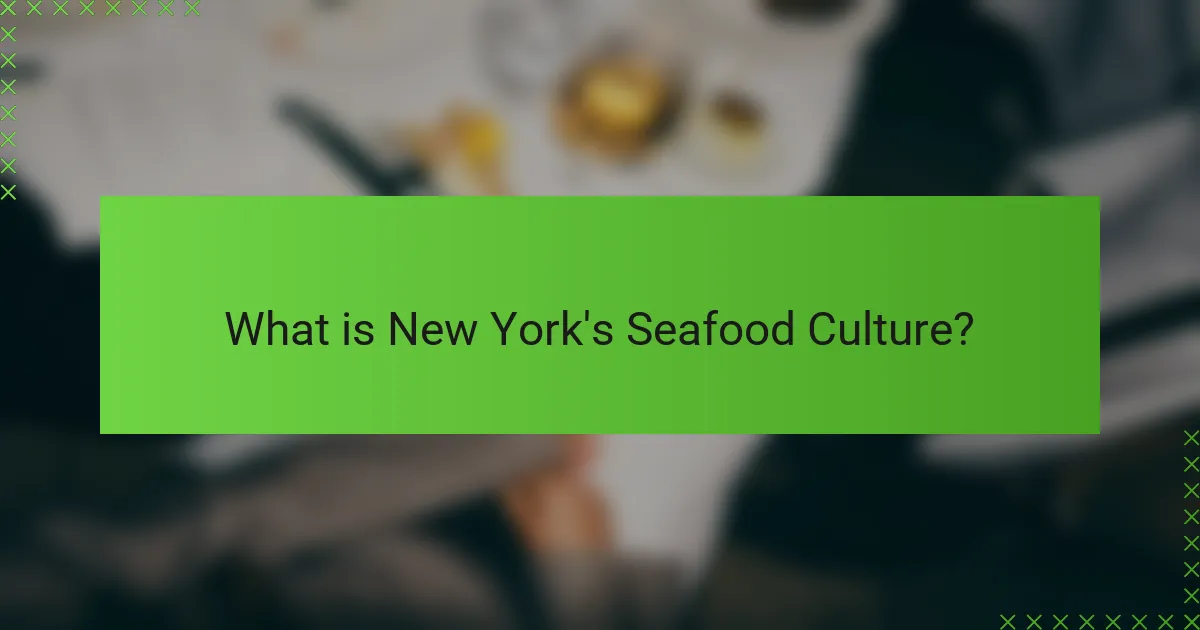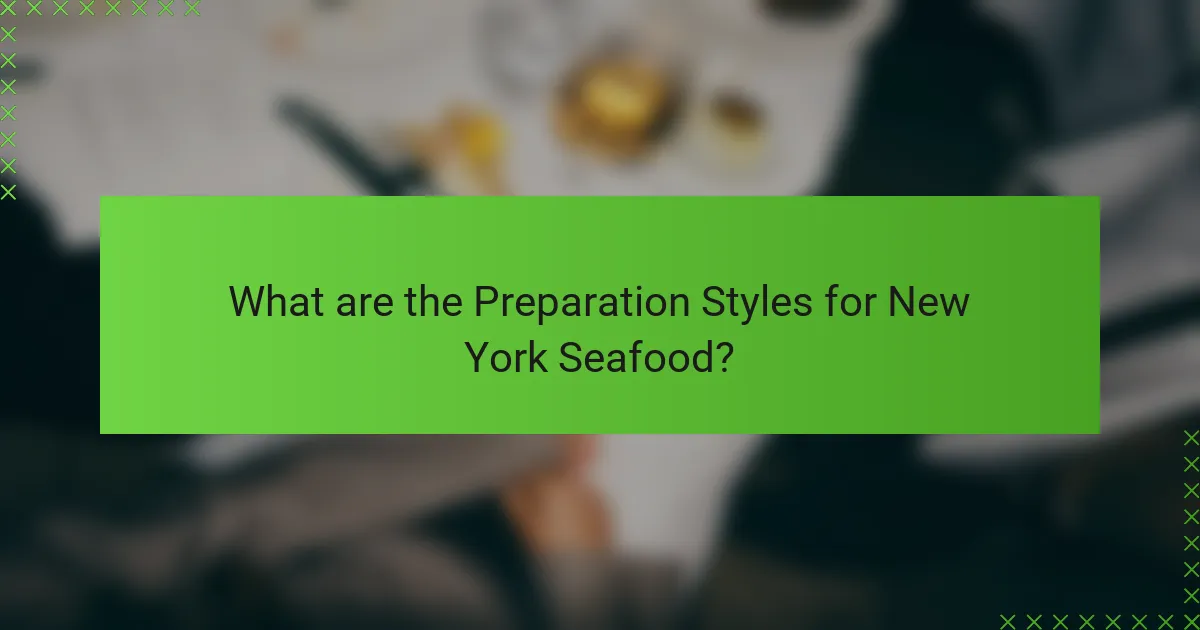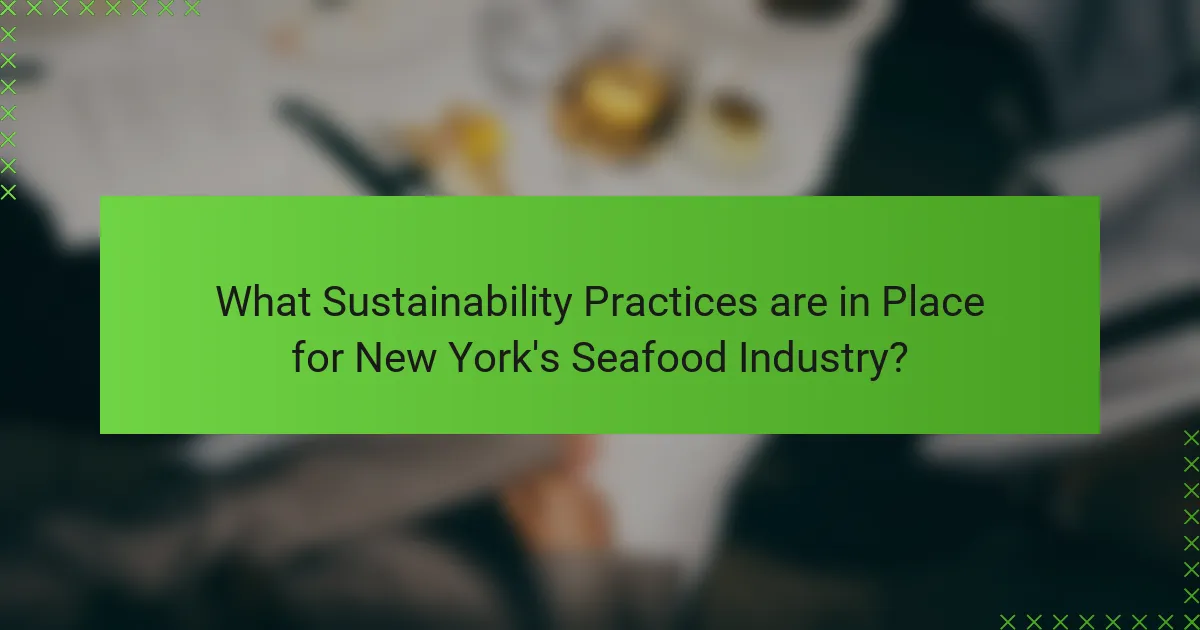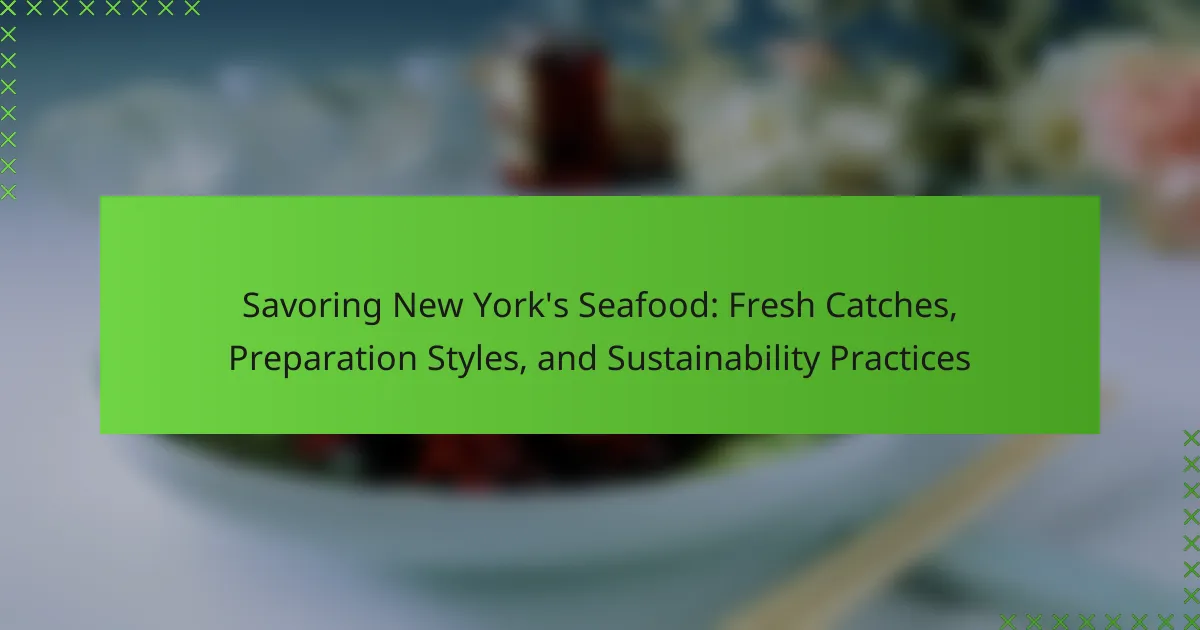
What is New York’s Seafood Culture?
New York’s seafood culture is a vibrant blend of diverse culinary influences and fresh local catches. The city’s proximity to the Atlantic Ocean provides access to a variety of seafood, including fish, shellfish, and crustaceans. Iconic dishes such as clam chowder and lobster rolls showcase this abundance. New York’s seafood markets, like the Fulton Fish Market, play a crucial role in sourcing fresh ingredients. The culture emphasizes sustainable fishing practices, reflecting a growing awareness of environmental impact. Restaurants often highlight seasonal seafood, promoting local and sustainable options. This commitment to freshness and sustainability enhances the dining experience. Overall, New York’s seafood culture is a dynamic reflection of its maritime heritage and culinary innovation.
How does the local geography influence seafood availability?
Local geography significantly influences seafood availability. Coastal regions provide access to diverse marine ecosystems. These ecosystems support various fish and shellfish species. For example, estuaries and bays serve as nurseries for juvenile fish. The availability of nutrients in these areas enhances fish populations. Additionally, water temperature and salinity impact species distribution. Areas with rocky shorelines often harbor different species than sandy beaches. Seasonal changes in geography can also affect migration patterns of fish. Therefore, local geography directly shapes the types and quantities of seafood available in a region.
What specific bodies of water contribute to New York’s seafood diversity?
The specific bodies of water that contribute to New York’s seafood diversity include the Atlantic Ocean, Long Island Sound, and the Hudson River. The Atlantic Ocean provides a rich habitat for various species, including flounder, cod, and scallops. Long Island Sound is known for its abundant shellfish, particularly clams and oysters. The Hudson River supports species like striped bass and bluefish, contributing to local fisheries. These bodies of water collectively enhance the variety of seafood available in New York.
How do seasonal changes affect seafood types in New York?
Seasonal changes significantly affect seafood types in New York. Different species thrive during various seasons due to water temperature and breeding cycles. For example, summer brings an abundance of striped bass and flounder. In contrast, winter sees an increase in species like cod and lobster. The fall season is notable for the migration of bluefish. These shifts impact availability in local markets and restaurants. According to the New York State Department of Environmental Conservation, seasonal fishing regulations help manage these changes. This ensures sustainable practices while catering to local seafood preferences.
What role does seafood play in New York’s culinary identity?
Seafood is a cornerstone of New York’s culinary identity. It reflects the city’s diverse cultural influences. The proximity to the Atlantic Ocean provides access to fresh catches. Iconic dishes include clam chowder and lobster rolls. Seafood markets, like Fulton Fish Market, highlight the industry’s significance. New York’s chefs emphasize sustainability in sourcing seafood. This commitment enhances the city’s reputation for responsible dining. The culinary scene showcases various preparation styles, from classic to innovative.
How have historical factors shaped seafood consumption in New York?
Historical factors have significantly shaped seafood consumption in New York. The city’s geographic location along the Atlantic Ocean has made it a prime hub for fishing and seafood trade. Early European settlers relied heavily on local fish and shellfish for sustenance. The establishment of ports in the 17th century facilitated the importation and exportation of various seafood. Industrialization in the 19th century further expanded seafood availability through advancements in refrigeration and transportation. Cultural diversity also played a role, as immigrant communities introduced new seafood dishes and preparation methods. Today, New Yorkers enjoy a rich variety of seafood reflecting these historical influences.
What are the signature seafood dishes of New York?
The signature seafood dishes of New York include clam chowder, lobster rolls, and oysters on the half shell. Clam chowder is a creamy soup that often features Manhattan or New England styles. Lobster rolls consist of lobster meat served in a toasted bun, typically with mayonnaise. Oysters on the half shell are served raw and are a popular delicacy in the city. Other notable dishes include shrimp cocktail and fish tacos. These dishes reflect New York’s rich seafood culture and access to fresh catches from the Atlantic Ocean.

What are the Fresh Catches Available in New York?
Fresh catches available in New York include striped bass, flounder, and black sea bass. Other options are scallops, clams, and oysters. These seafood varieties are often sourced from local waters. The Hudson River and Long Island Sound are key fishing areas. Seasonal availability may affect the types of fish caught. Regulations help maintain sustainable fishing practices. Local markets frequently showcase these fresh catches. Many restaurants emphasize farm-to-table sourcing for seafood.
Which seafood species are most commonly caught in New York waters?
The seafood species most commonly caught in New York waters include striped bass, flounder, and bluefish. Striped bass is highly sought after for its flavor and size. Flounder is popular for its delicate texture and versatility in cooking. Bluefish is known for its strong taste and is often used in various dishes. According to the New York State Department of Environmental Conservation, these species are prevalent in both commercial and recreational fishing. The abundance of these fish is supported by their adaptability to the local ecosystem.
What are the peak seasons for different seafood species?
Peak seasons for different seafood species vary based on their breeding and migration patterns. For instance, salmon is typically in season from May to September. Blue crabs are best from late spring through early fall, peaking in June and July. Oysters are most abundant from September to April, with a peak in winter months. Scallops are generally harvested from November to March. Cod is best from winter through early spring, particularly from January to April. Each species has specific timeframes based on regional fishing regulations and environmental factors. These seasonal patterns help ensure sustainable fishing practices.
How do fishing regulations impact the types of seafood available?
Fishing regulations significantly impact the types of seafood available in a region. These regulations dictate which species can be harvested, the size and quantity limits, and the seasons for fishing. By enforcing these rules, authorities aim to protect overfished species and ensure sustainable practices. For example, the New York State Department of Environmental Conservation regulates species like striped bass and flounder to prevent depletion. Such regulations can lead to a decrease in the availability of certain seafood types during specific seasons. Conversely, they may also promote the growth of less commonly harvested species, increasing their availability over time. Overall, fishing regulations play a crucial role in maintaining ecological balance and ensuring a diverse seafood supply.
What are the health benefits of consuming fresh seafood?
Consuming fresh seafood offers numerous health benefits. It is a rich source of high-quality protein essential for muscle growth and repair. Fresh seafood contains omega-3 fatty acids, which are known to support heart health by reducing inflammation and lowering blood pressure. Regular consumption can improve brain function, as these fatty acids are vital for cognitive health. Seafood is also packed with essential vitamins and minerals, including vitamin D and selenium, which contribute to overall well-being. Studies indicate that people who eat seafood regularly have a lower risk of chronic diseases, such as heart disease and stroke. Furthermore, fresh seafood is generally lower in saturated fat compared to other protein sources, making it a healthier choice for maintaining a balanced diet.
Which nutrients are abundant in New York seafood?
New York seafood is abundant in omega-3 fatty acids, protein, and essential vitamins. Omega-3 fatty acids support heart health and brain function. Protein is vital for muscle repair and overall bodily functions. Essential vitamins include B12 and D, important for energy production and bone health. Seafood from New York also contains minerals like selenium and iodine. These nutrients contribute to a balanced diet and promote overall well-being. The nutritional profile varies among different seafood species, such as fish and shellfish.
How does fresh seafood contribute to a balanced diet?
Fresh seafood contributes to a balanced diet by providing essential nutrients. It is a rich source of high-quality protein, which is vital for muscle repair and growth. Fresh seafood also contains omega-3 fatty acids, known for promoting heart health. These fatty acids can lower blood pressure and reduce the risk of heart disease. Additionally, seafood is low in saturated fat, making it a healthier alternative to red meats. It is also packed with vitamins and minerals, including vitamin D and selenium, which support immune function. According to the Dietary Guidelines for Americans, seafood consumption is recommended at least twice a week for optimal health benefits.

What are the Preparation Styles for New York Seafood?
New York seafood is prepared using various styles that highlight freshness and flavor. Common preparation styles include grilling, frying, steaming, and poaching. Grilling enhances the natural taste of fish and shellfish while adding a smoky flavor. Frying creates a crispy texture, popular for dishes like fried calamari. Steaming preserves moisture and nutrients, making it ideal for delicate seafood. Poaching involves gently cooking in liquid, often with herbs and spices, to infuse flavor. These methods reflect the culinary diversity found in New York’s seafood cuisine. Each style is chosen to complement the specific type of seafood being prepared.
What cooking methods are popular for preparing seafood in New York?
Grilling, steaming, and frying are popular cooking methods for preparing seafood in New York. Grilling imparts a smoky flavor and is often used for fish like salmon and swordfish. Steaming preserves moisture and is commonly used for shellfish such as clams and mussels. Frying, including deep-frying and pan-frying, creates a crispy texture and is popular for dishes like fried calamari and fish and chips. These methods reflect the diverse culinary influences found in New York’s seafood cuisine.
How does grilling differ from frying in seafood preparation?
Grilling and frying are distinct methods of seafood preparation. Grilling involves cooking seafood over direct heat, often resulting in a smoky flavor. This technique typically uses high temperatures and can enhance the natural taste of the seafood. In contrast, frying involves cooking seafood in oil or fat, which can create a crispy texture. Frying often requires lower temperatures compared to grilling. Additionally, grilling allows excess fats to drip away, making it a healthier option. Frying, however, can add richness due to the oil absorption. Each method impacts the final flavor and texture of the seafood differently.
What are traditional recipes that showcase New York seafood?
Traditional recipes that showcase New York seafood include clam chowder, lobster rolls, and fish fry. Clam chowder is a creamy soup made with fresh clams, potatoes, and onions. It reflects New York’s rich maritime heritage. Lobster rolls consist of lobster meat mixed with mayonnaise, served in a toasted bun. This dish highlights the state’s access to fresh lobster from the Atlantic. Fish fry typically features local fish, such as flounder or cod, coated in batter and deep-fried. This method of preparation is popular at seaside restaurants and reflects local fishing traditions. Each recipe emphasizes the freshness and quality of New York’s seafood.
How can seafood be paired with local ingredients?
Seafood can be paired with local ingredients by utilizing fresh produce and herbs from nearby farms. For instance, clams can be complemented with locally grown corn and tomatoes. This enhances flavor and supports local agriculture. Additionally, fish can be served with seasonal vegetables like asparagus or zucchini. Pairing seafood with local grains, such as quinoa or farro, creates a nutritious meal. Local cheeses can also add richness, like a smoked gouda with grilled shrimp. Using regional spices and condiments, such as New York’s craft hot sauces, can elevate the dish further. This approach not only boosts flavor but also promotes sustainability by reducing transportation emissions.
What are the best local sides to serve with New York seafood?
The best local sides to serve with New York seafood include coleslaw, roasted potatoes, and corn on the cob. Coleslaw provides a refreshing crunch that complements seafood flavors. Roasted potatoes add a hearty texture and are a popular choice. Corn on the cob is a seasonal favorite that enhances the meal’s sweetness. These sides are commonly enjoyed with seafood dishes in New York. Their popularity is rooted in local dining traditions and seasonal availability.
How do local wines complement seafood dishes?
Local wines enhance seafood dishes through their complementary flavors and acidity. Wines from coastal regions often feature crisp profiles that balance the richness of seafood. For instance, a local Sauvignon Blanc pairs well with oysters due to its zesty notes. Similarly, Chardonnay can complement buttery fish like salmon. The acidity in these wines cuts through the fat in seafood, creating a harmonious taste. Studies show that regional pairings often highlight the freshness of both the wine and the catch. This synergy elevates the dining experience, making it more enjoyable. Local wines also reflect the terroir, enhancing the sense of place in seafood dishes.

What Sustainability Practices are in Place for New York’s Seafood Industry?
New York’s seafood industry implements various sustainability practices to protect marine ecosystems. These practices include regulated fishing quotas to prevent overfishing. The industry also promotes the use of sustainable fishing methods, such as traps and lines, which reduce bycatch. Aquaculture is another focus, with farms producing seafood in environmentally responsible ways. Certification programs, like the Marine Stewardship Council, help consumers identify sustainably sourced seafood. Additionally, local initiatives encourage community-supported fisheries, connecting consumers directly with local fishermen. These measures aim to ensure the long-term viability of seafood resources in New York.
What initiatives are being taken to promote sustainable fishing in New York?
New York is implementing several initiatives to promote sustainable fishing. The New York State Department of Environmental Conservation (DEC) oversees regulations to protect fish populations. These regulations include size and catch limits for various species. The DEC also conducts research to monitor fish stocks and ecosystem health.
Additionally, there are programs aimed at educating fishermen about sustainable practices. The New York Sea Grant program provides resources for best practices in fishing. Community-supported fisheries (CSFs) are also growing, connecting local fishermen with consumers. These initiatives aim to ensure the long-term viability of fish resources in New York waters.
How do local fisheries ensure the health of marine ecosystems?
Local fisheries ensure the health of marine ecosystems through sustainable fishing practices. They implement quotas to prevent overfishing and allow fish populations to recover. Many fisheries use selective gear to minimize bycatch, protecting non-target species. They also participate in habitat restoration projects to enhance marine environments. Regular monitoring of fish stocks helps maintain ecological balance. Local fisheries often engage in community education about marine conservation. Collaboration with scientists ensures that practices are based on current research. These efforts contribute to the overall sustainability of marine ecosystems.
What role do consumers play in supporting sustainable seafood practices?
Consumers play a crucial role in supporting sustainable seafood practices. By choosing seafood certified by organizations like the Marine Stewardship Council, consumers encourage responsible fishing methods. Their purchasing decisions directly influence market demand for sustainably sourced seafood. Increased demand for sustainable options incentivizes suppliers to adopt eco-friendly practices. Additionally, consumers can educate themselves about overfished species and avoid purchasing them. This awareness helps reduce pressure on declining fish populations. Engaging in advocacy for sustainable fisheries also empowers consumers to influence policy changes. Overall, consumer choices significantly impact the sustainability of seafood industries.
How can individuals make sustainable seafood choices?
Individuals can make sustainable seafood choices by selecting seafood that is certified by reputable organizations. Look for labels like the Marine Stewardship Council (MSC) or the Aquaculture Stewardship Council (ASC). These certifications indicate that the seafood was sourced sustainably. Additionally, individuals should choose species that are abundant and not overfished. Resources like the Seafood Watch guide provide updated recommendations on sustainable options. It is also important to consider the fishing methods used. Methods such as pole-and-line or traps are generally more sustainable than trawling. By being informed and making conscious choices, individuals can support sustainable fishing practices.
What resources are available for finding sustainable seafood options?
Resources for finding sustainable seafood options include the Seafood Watch program by the Monterey Bay Aquarium. This program offers a comprehensive guide to seafood choices based on sustainability. The Environmental Defense Fund also provides a seafood selector tool that helps consumers make informed choices. Additionally, the Marine Stewardship Council certifies sustainable fisheries and products. Local seafood markets may also have information on their sourcing practices. Online platforms like FishChoice provide resources for businesses to source sustainable seafood. The National Oceanic and Atmospheric Administration offers guidelines on sustainable fishing practices. These resources help consumers and businesses make environmentally responsible seafood choices.
How can one identify overfished species to avoid?
To identify overfished species to avoid, consult seafood sustainability guides. These guides provide updated information on the status of various fish species. Organizations like the Marine Stewardship Council and Seafood Watch offer reliable resources. They assess fish populations and fishing practices. Look for labels indicating sustainable sourcing. Avoid species listed as overfished or threatened. The U.S. National Oceanic and Atmospheric Administration also tracks fish stock assessments. They publish data on the health of fish populations. Following these resources helps consumers make informed choices.
What are the best practices for enjoying New York’s seafood?
To enjoy New York’s seafood, prioritize freshness by sourcing from reputable markets or restaurants. Look for seafood that is in season, as it tends to be of higher quality. Pay attention to sustainability by choosing seafood certified by organizations like the Marine Stewardship Council. When dining out, ask about the origin of the seafood to ensure it is locally sourced. Experiment with various preparation styles, such as grilling or steaming, to enhance flavor. Pair seafood with complementary sides, like seasonal vegetables or grains, to create a balanced meal. Lastly, consider participating in seafood tastings or festivals to expand your palate and knowledge.
How can one ensure freshness when purchasing seafood?
To ensure freshness when purchasing seafood, look for clear, bright eyes and shiny skin. Fresh seafood should have a mild, ocean-like smell, not a strong fishy odor. Check for firm texture; fresh fish should spring back when pressed. The flesh should be moist and glistening, indicating freshness. If buying shellfish, ensure they are alive and tightly closed. Ice should be present in the display case, keeping the seafood cold. Purchase from reputable sources that prioritize freshness and sustainability. Research shows that seafood freshness significantly affects flavor and quality, making these checks essential.
What tips should be followed for safe seafood preparation at home?
To ensure safe seafood preparation at home, follow these key tips. First, purchase seafood from reputable sources to guarantee freshness and quality. Keep seafood refrigerated at temperatures below 40°F to prevent bacterial growth. Thaw frozen seafood in the refrigerator, not at room temperature, to maintain safety. Always wash hands, utensils, and surfaces with soap and hot water before and after handling seafood. Cook seafood to an internal temperature of 145°F to effectively kill harmful bacteria and parasites. Avoid cross-contamination by using separate cutting boards for seafood and other foods. Lastly, consume seafood promptly after cooking to ensure safety and quality.
The main entity of the article is New York’s seafood culture, characterized by its fresh catches, diverse preparation styles, and commitment to sustainability. The article provides an overview of the seafood available in New York, highlighting key species, seasonal changes, and the influence of local geography. It discusses the historical factors shaping seafood consumption, signature dishes, and the importance of sustainable fishing practices. Additionally, the article outlines best practices for enjoying seafood, including safe preparation methods and pairing with local ingredients. Overall, it emphasizes the significance of seafood in New York’s culinary identity and its role in promoting environmental responsibility.
